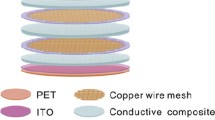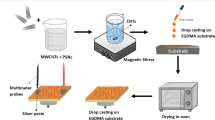Abstract
Composite of carbon black (CB) dispersed into a multicomponent polyurethane matrix combines the good mechanical properties of the polymer, such as elasticity, with the electrical property of the conducting particles. Electrical current–voltage (I × V) analysis found the percolation threshold through the sample surface to be between 0.6 and 0.8 vol%. Below the percolation threshold concentration (pc), the effect of the Coulomb potential is accentuated on the CB dispersion, while in the region over pc, the London–van der Waals potential is important. The repeatability in the piezoresistive behavior was observed under the application of several loading cycles. The gauge factors obtained were 4.9 and 2.0 for samples with 0.8 and 1.0 vol% of CB, respectively. The results indicate that the material can be used as a piezoresistive sensor.








Similar content being viewed by others
References
Capineri L (2014) Resistive sensors with smart textiles for wearable technology: from fabrication process to integration with electronics. Procedia Eng 87:724–727. https://doi.org/10.1016/j.proeng.2014.11.748
Abdelhamid S, Hassanein HS, Takahara G (2014) Vehicle as a mobile sensor. Procedia Comput Sci 34:286–295. https://doi.org/10.1016/j.procs.2014.07.025
Ciuti G, Ricotti L, Menciassi A, Dario P (2015) MEMS sensor technologies for human centred applications in healthcare, physical activities, safety and environmental sensing: a review on research activities in Italy. Sensors 15:6441–6468. https://doi.org/10.3390/s150306441
Person MR, Eaton MJ, Pullin R, Featherston CA, Holford KM (2012) energy harvesting for aerospace structural health monitoring systems. J Phys Conf Ser 382:012025. https://doi.org/10.1088/1742-6596/382/1/012025
Lyndon M, Robinson D, Taylor SE, Amato G, Brien EJO, Uddin N (2017) Improved axle detection for bridge weigh-in-motion systems using fiber optic sensors. J Civil Struct Health Monit 7:325–332. https://doi.org/10.1007/s13349-017-0229-4
Xie J, Long H, Miao M (2016) High sensitivity knitted fabric strain sensors. Smart Mater Struct 25:105008. https://doi.org/10.1088/0964-1726/25/10/105008
Dai H, Thostenson ET, Schumacher T (2015) Processing and characterization of a novel distributed strain sensor using carbon nanotube-based nonwoven composites. Sensors 15:17728–17747. https://doi.org/10.3390/s150717728
Zhai T, Li D, Fei G, Xia H (2015) Piezoresistive and compression resistance relaxation behavior of water blown carbon nanotube/polyurethane composite foam. Compos Part A 72:108–114. https://doi.org/10.1016/j.compositesa.2015.02.003
Moghaddam MK, Breede A, Brauner C, Lang W (2015) Embedding piezoresistive pressure sensors to obtain online pressure profiles inside fiber composite laminates. Sensors 15:7499–7511. https://doi.org/10.3390/s150407499
Yu X, Kwon E (2009) A carbon nanotube/cement composite with piezoresistive properties. Smart Mater Struct 18:055010. https://doi.org/10.1088/0964-1726/18/5/055010
Chung DDL (1998) Self-monitoring structural materials. Mater Sci Eng Rev 22:57–78. https://doi.org/10.1016/S0927-796X(97)00021-1
Chung DDL (2004) Electrically conductive cement-based materials. Adv Cem Res 16:167–176. https://doi.org/10.1680/adcr.2004.16.4.167
Chung DDL (2012) Carbon materials for structural self-sensing, electromagnetic shielding and thermal interfacing. Carbon 50:3342–3353. https://doi.org/10.1016/j.carbon.2012.01.031
Sugiyama S, Takigawa M, Igarashi I (1983) Integrated piezoresistive pressure sensor with both voltage and frequency output. Sens Actuators 4:113–120. https://doi.org/10.1016/0250-6874(83)85015-X
Porter TL, Eastman MP, Pace DL, Bradley M (2001) Sensor based on piezoresistive microcantilever technology. Sens Actuators A Phys 88:47–51. https://doi.org/10.1016/S0924-4247(00)00498-2
Roy AL, Sarkar H, Dutta A, Bhattacharyya TK (2014) A high precision SOI MEMS–CMOS piezoresistive accelerometer. Sens Actuators A Phys 210:77–85. https://doi.org/10.1016/j.sna.2014.01.036
Li X, Bao M, Yang H, Shen S, Lu D (1999) A micromachined piezoresistive angular rate sensor with a composite beam structure. Sens Actuators A Phys 72:217–223. https://doi.org/10.1016/S0924-4247(98)00220-9
Fragiacomo G, Ansbaek T, Pedersen T, Hansen O, Thomsen EV (2010) Analysis of small deflection touch mode behavior in capacitive pressure sensors. Sens Actuators A Phys 161:114–119. https://doi.org/10.1016/j.sna.2010.04.030
Wu X, Han Y, Zhang X, Lu C (2016) Highly sensitive, stretchable, and wash-durable strain sensor based on ultrathin conductive layer@ polyurethane yarn for tiny motion monitoring. ACS Appl Mater Interfaces 8:9936–9945. https://doi.org/10.1021/acsami.6b01174
Li F, Qi L, Yang J, Xu M, Luo X, Ma D (2000) Polyurethane/conducting carbon black composites: structure, electric conductivity, strain recovery behavior, and their relationships. J Appl Polym Sci 75:68–77. https://doi.org/10.1002/(SICI)1097-4628(20000103)75:1%3c68:AID-APP8%3e3.0.CO;2-I
Rodrigues PC, Akcelrud L (2003) Networks and blends of polyaniline and polyurethane: correlations between composition and thermal, dynamic mechanical and electrical properties. Polymer 44:6891–6899. https://doi.org/10.1016/j.polymer.2003.08.024
Chen SG, Hu XL, Hu J, Zhang MQ, Rong MZ, Zheng Q (2006) Relationships between organic vapor adsorption behaviors and gas sensitivity of carbon black filled waterborne polyurethane composites. Sens Actuators B 119:110–117. https://doi.org/10.1016/j.snb.2005.12.002
Zhao B, Fu RW, Zhang MQ, Zhang B, Zeng W, Rong MZ, Zheng Q (2007) Analysis of gas sensing behaviors of carbon black/waterborne polyurethane composites in low concentration organic vapors. J Mater Sci 42:4575–4580. https://doi.org/10.1007/s10853-006-0517-6
Bunde A, Dieterich W (2000) Percolation in composites. J Electroceram 5:81–92. https://doi.org/10.1023/A:1009997800513
Zheng S, Deng J, Yang L, Ren D, Huang S, Yang W, Liu Z, Mingbo Yang M (2014) Investigation on the piezoresistive behavior of high-density polyethylene/carbon black films in the elastic and plastic regimes. Compos Sci Technol 97:34–40. https://doi.org/10.1016/j.compscitech.2014.04.001
Strümpler R, Glatz-Reichenbach J (1999) Conducting polymer composites. J Electroceram 3:329–346. https://doi.org/10.1023/a:1009909812823
Sanches AO, Kanda DHF, Malmonge LF, Silva MJ, Sakamoto WK, Malmonge JA (2017) Synergistic effects on polyurethane/lead zirconate titanate/carbon black three-phase composites. Polym Test 60:253–259. https://doi.org/10.1016/j.polymertesting.2017.03.031
Guo X, Huang Y, Zhao Y, Mao L, Gao L, Pan W, Zhang Y, Liu P (2017) Ηighly stretchable strain sensor based on SWCNTs/CB synergistic conductive network for wearable human-activity monitoring and recognition. Smart Mater Struct 26:095017. https://doi.org/10.1088/1361-665X/aa79c3
Vionnet-Menot S, Grimaldi C, Maeder T, Strässler S, Ryser P (2005) Tunneling-percolation origin of nonuniversality: theory and experiments. Phys Rev B 71:064201. https://doi.org/10.1103/PhysRevB.71.064201
Flandin L, Hiltner A, Baer E (2001) Interrelationships between electrical and mechanical properties of a carbon black-filled ethylene–octene elastomer. Polymer 42:827–838. https://doi.org/10.1016/S0032-3861(00)00324-4
Luheng W, Tianhuai D, Peng W (2009) Influence of carbon black concentration on piezoresistivity for carbon-black-filled silicone rubber composite. Carbon 47:3151–3157. https://doi.org/10.1016/j.carbon.2009.06.050
Rebeque PV, Silva MJ, Cena CR, Nagashima HN, Malmonge JA, Kanda DHF (2019) Analysis of the electrical conduction in percolative nanocomposites based on castor-oil polyurethane with carbon black and activated carbon nanopowder. Polym Compos 40:7–15. https://doi.org/10.1002/pc.24588
Zhai T, Li D, Fei G, Xia H (2015) Piezoresistive and compression resistance relaxation behavior of water blown carbon nanotube/polyurethane composite foam. Compos Part A Appl Sci Manuf 72:108–114. https://doi.org/10.1016/j.compositesa.2015.02.003
Sobha AP, Narayanankutty SK (2015) Improved strain sensing property of functionalised multiwalled carbon nanotube/polyaniline composites in TPU matrix. Sens Actuators A 233:98–107. https://doi.org/10.1016/j.sna.2015.06.012
Mather PJ, Thomas KM (1997) Carbon black/high density polyethylene conducting composite materials: part II The relationship between the positive temperature coefficient and the volume resistivity. J Mater Sci 32:1711–1715. https://doi.org/10.1023/A:1018567731526
Petrović ZS, Martinović B, Divjaković V, Budinski-Simendić J (1993) Polypropylene–carbon black interaction in conductive composites. J Appl Polym Sci 49:1659–1669. https://doi.org/10.1002/app.1993.070490919
Fu SY, Feng XQ, Lauke B, Mai YW (2008) Effects of particle size, particle/matrix interface adhesion and particle loading on mechanical properties of particulate–polymer composites. Compos Part B Eng 39:933–961. https://doi.org/10.1016/j.compositesb.2008.01.002
Zhang S, Liu H, Yang S, Shi X, Zhang D, Shan C, Guo Z (2019) Ultrasensitive and highly compressible piezoresistive sensor based on polyurethane sponge coated with cracked cellulose nanofibril/silver nanowire layer. ACS Appl Mater Interfaces. https://doi.org/10.1021/acsami.9b00900
Christ JF, Hohimer CJ, Aliheidari N, Ameli A, Mo C, Pötschke P (2017) 3D printing of highly elastic strain sensors using polyurethane/multiwall carbon nanotube composites. Proc SPIE 10168:101680E. https://doi.org/10.1117/12.2259820
Das NC, Chaki TK, Khastgir D (2002) Effect of axial stretching on electrical resistivity of short carbon fibre and carbon black filled conductive rubber composites. Polym Int 51:156–163. https://doi.org/10.1002/pi.811
Aneli JN, Zaikov GE, Khananashvili LM (1999) Effects of mechanical deformations on the structurization and electric conductivity of electric conducting polymer composites. J Appl Polym Sci 74:601–621. https://doi.org/10.1002/(SICI)1097-4628(19991017)74:3%3c601:AID-APP14%3e3.0.CO;2-K
Yamaguchi K, Busfield JJC, Thomas AG (2003) Electrical and mechanical behavior of filled elastomers. J Polym Sci Part B Polym Phys 41:2079–2089. https://doi.org/10.1002/polb.10571
Busfield JJC, Thomas AG, Yamaguchi K (2005) Electrical and mechanical behavior of filled rubber. III. Dynamic loading and the rate of recovery. J Polym Sci Part B Polym Phys 43:1649–1661. https://doi.org/10.1002/polb.20452
Flandin L, Chang A, Nazarenko S, Hiltner A, Baer E (2000) Effect of strain on the properties of an ethylene–octene elastomer with conductive carbon fillers. J Appl Polym Sci 76:894–905. https://doi.org/10.1002/(SICI)1097-4628(20000509)76:6%3c894:AID-APP16%3e3.0.CO;2-K
Zhang R, Deng H, Valenca R, Jin J, Fu Q, Bilotti E, Peijs T (2013) Strain sensing behavior of elastomeric composite films containing carbon nanotubes under cyclic loading. Compos Sci Technol 74:1–5. https://doi.org/10.1016/j.compscitech.2012.09.016
Lillemose M, Spieser M, Christiansen NO, Christensen A, Boisen A (2008) Intrinsically conductive polymer thin film piezoresistors. Microelectron Eng 85:969–971. https://doi.org/10.1016/j.mee.2007.12.020
Ku-Herrera JJ, Avilés F, Seidel GD (2013) Self-sensing of elastic strain, matrix yielding and plasticity in multiwall/carbon nanotube vinyl ester composites. Smart Mater Struct 22:085003. https://doi.org/10.1088/0964-1726/22/8/085003
Zhou L, Jung S, Brandon E, Jackson TN (2006) Flexible substrate microcrystalline silicon and gated amorphous silicon strain sensors. IEEE Trans Electron Devices 53:380–385. https://doi.org/10.1109/TED.2005.861727
Stassi S, Cauda V, Canavese G, Pirri CF (2014) Flexible tactile sensing based on piezoresistive composites: a review. Sensors 14:5296–5332. https://doi.org/10.3390/s140305296
Theodosiou TC, Saravanos DA (2010) Numerical investigation of mechanisms affecting the piezoresistive properties of CNT doped polymers using multi-scale models. Compos Sci Technol 70:1312–1320. https://doi.org/10.1016/j.compscitech.2010.04.003
Hu N, Karube Y, Arai M, Watanabe T, Yan C, Li Y, Liu Y, Fukunaga H (2010) Investigation on sensitivity of a polymer/carbon nanotube composite strain sensor. Carbon 48:680–687. https://doi.org/10.1016/j.carbon.2009.10.012
Pham GT, Park YB, Liang Z, Zhang C, Wang B (2008) Processing and modeling of conductive thermoplastic/carbon nanotubes films for strain sensing. Compos Part B Eng 39:209–216. https://doi.org/10.1016/j.compositesb.2007.02.024
Bautista-Quijano JR, Avilés F, Aguilar JO, Tapia A (2010) A strain sensing capabilities of a piezoresistive MWCNT–polysulfone film. Sens Actuators A Phys 159:135–140. https://doi.org/10.1016/j.sna.2010.03.005
Zhang W, Suhr J, Koratkar N (2006) Carbon nanotube/polycarbonate composites as multifunctional strain sensors. J Nanosci Nanotechnol 6:960–964. https://doi.org/10.1166/jnn.2006.171
Yi W, Wang Y, Wang G, Tao X (2012) Investigation of carbon black/silicone elastomer/dimethylsilicone oil composites for flexible strain sensors. Polym Test 31:677–684. https://doi.org/10.1016/j.polymertesting.2012.03.006
Oliva-Avilés AI, Avilés F, Sosa V (2009) Electrical and piezoresistive properties of multi-walled carbon nanotube/polymer composite films aligned by an electric field. Carbon 49:2989–2997. https://doi.org/10.1016/j.carbon.2011.03.017
Acknowledgements
Thanks are due to Coordination for the Improvement of Higher Level or Education Personnel (CAPES) for financial support and to the Mato Grosso Research Foundation (FAPEMAT) for providing equipment to the laboratory and allowing for analysis.
Author information
Authors and Affiliations
Corresponding author
Additional information
Publisher's Note
Springer Nature remains neutral with regard to jurisdictional claims in published maps and institutional affiliations.
Rights and permissions
About this article
Cite this article
Sousa, E.A., Lima, T.H.C., Arlindo, E.P.S. et al. Multicomponent polyurethane–carbon black composite as piezoresistive sensor. Polym. Bull. 77, 3017–3031 (2020). https://doi.org/10.1007/s00289-019-02888-8
Received:
Revised:
Accepted:
Published:
Issue Date:
DOI: https://doi.org/10.1007/s00289-019-02888-8




